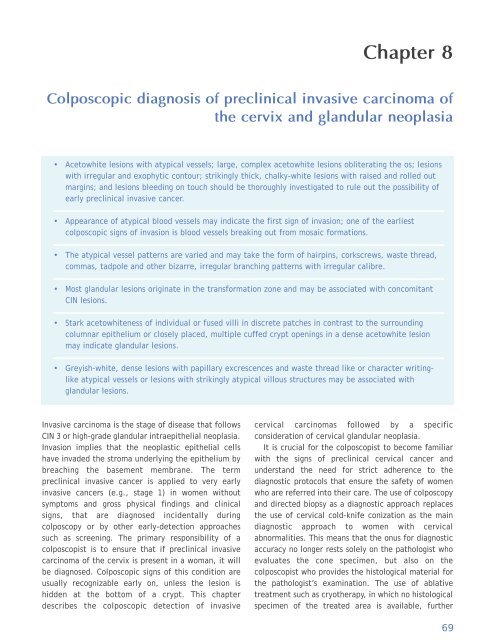Colposcopy and Treatment of Cervical Intraepithelial Neoplasia - RHO
Colposcopy and Treatment of Cervical Intraepithelial Neoplasia - RHO
Colposcopy and Treatment of Cervical Intraepithelial Neoplasia - RHO
Create successful ePaper yourself
Turn your PDF publications into a flip-book with our unique Google optimized e-Paper software.
Chapter 8<br />
Colposcopic diagnosis <strong>of</strong> preclinical invasive carcinoma <strong>of</strong><br />
the cervix <strong>and</strong> gl<strong>and</strong>ular neoplasia<br />
• Acetowhite lesions with atypical vessels; large, complex acetowhite lesions obliterating the os; lesions<br />
with irregular <strong>and</strong> exophytic contour; strikingly thick, chalky-white lesions with raised <strong>and</strong> rolled out<br />
margins; <strong>and</strong> lesions bleeding on touch should be thoroughly investigated to rule out the possibility <strong>of</strong><br />
early preclinical invasive cancer.<br />
• Appearance <strong>of</strong> atypical blood vessels may indicate the first sign <strong>of</strong> invasion; one <strong>of</strong> the earliest<br />
colposcopic signs <strong>of</strong> invasion is blood vessels breaking out from mosaic formations.<br />
• The atypical vessel patterns are varied <strong>and</strong> may take the form <strong>of</strong> hairpins, corkscrews, waste thread,<br />
commas, tadpole <strong>and</strong> other bizarre, irregular branching patterns with irregular calibre.<br />
• Most gl<strong>and</strong>ular lesions originate in the transformation zone <strong>and</strong> may be associated with concomitant<br />
CIN lesions.<br />
• Stark acetowhiteness <strong>of</strong> individual or fused villi in discrete patches in contrast to the surrounding<br />
columnar epithelium or closely placed, multiple cuffed crypt openings in a dense acetowhite lesion<br />
may indicate gl<strong>and</strong>ular lesions.<br />
• Greyish-white, dense lesions with papillary excrescences <strong>and</strong> waste thread like or character writinglike<br />
atypical vessels or lesions with strikingly atypical villous structures may be associated with<br />
gl<strong>and</strong>ular lesions.<br />
Invasive carcinoma is the stage <strong>of</strong> disease that follows<br />
CIN 3 or high-grade gl<strong>and</strong>ular intraepithelial neoplasia.<br />
Invasion implies that the neoplastic epithelial cells<br />
have invaded the stroma underlying the epithelium by<br />
breaching the basement membrane. The term<br />
preclinical invasive cancer is applied to very early<br />
invasive cancers (e.g., stage 1) in women without<br />
symptoms <strong>and</strong> gross physical findings <strong>and</strong> clinical<br />
signs, that are diagnosed incidentally during<br />
colposcopy or by other early-detection approaches<br />
such as screening. The primary responsibility <strong>of</strong> a<br />
colposcopist is to ensure that if preclinical invasive<br />
carcinoma <strong>of</strong> the cervix is present in a woman, it will<br />
be diagnosed. Colposcopic signs <strong>of</strong> this condition are<br />
usually recognizable early on, unless the lesion is<br />
hidden at the bottom <strong>of</strong> a crypt. This chapter<br />
describes the colposcopic detection <strong>of</strong> invasive<br />
cervical carcinomas followed by a specific<br />
consideration <strong>of</strong> cervical gl<strong>and</strong>ular neoplasia.<br />
It is crucial for the colposcopist to become familiar<br />
with the signs <strong>of</strong> preclinical cervical cancer <strong>and</strong><br />
underst<strong>and</strong> the need for strict adherence to the<br />
diagnostic protocols that ensure the safety <strong>of</strong> women<br />
who are referred into their care. The use <strong>of</strong> colposcopy<br />
<strong>and</strong> directed biopsy as a diagnostic approach replaces<br />
the use <strong>of</strong> cervical cold-knife conization as the main<br />
diagnostic approach to women with cervical<br />
abnormalities. This means that the onus for diagnostic<br />
accuracy no longer rests solely on the pathologist who<br />
evaluates the cone specimen, but also on the<br />
colposcopist who provides the histological material for<br />
the pathologist’s examination. The use <strong>of</strong> ablative<br />
treatment such as cryotherapy, in which no histological<br />
specimen <strong>of</strong> the treated area is available, further<br />
69
















